
The Death Valley pupfish, also known as Salt Creek pupfish, is a small species of fish in the family Cyprinodontidae found only in Death Valley National Park, California, United States. There are two recognized subspecies: C. s. salinus and C. s. milleri. The Death Valley pupfish is endemic to two small, isolated locations and currently classified as endangered.

Flower chafers are a group of scarab beetles, comprising the subfamily Cetoniinae. Many species are diurnal and visit flowers for pollen and nectar, or to browse on the petals. Some species also feed on fruit. The group is also called fruit and flower chafers, flower beetles and flower scarabs. There are around 4,000 species, many of them still undescribed.

Rumex hymenosepalus, commonly known as canaigre, canaigre dock, ganagra, wild rhubarb, Arizona dock, and tanner's dock, is a perennial flowering plant which is native to the North American deserts in the southwestern United States and northern Mexico. It is a common food plant of the ruddy copper larvae.
Robert Rush Miller "was an important figure in American ichthyology and conservation from 1940 to the 1990s."

Harpalus is a genus of ground beetle first described by Pierre André Latreille in 1802.

Zabrus is a genus of ground beetles. They are, unusually for ground beetles, omnivores or even herbivores, and Zabrus tenebrioides can become a pest in cereal fields.

Acupalpus is a genus of insect-eating beetle species. Its representatives are found across Europe, Asia, and North America.

Broscinae is a subfamily of ground beetles in the family Carabidae. There are more than 30 genera and at least 340 described species in Broscinae.

Scaphinotus is a genus of beetles in the family Carabidae. There are at least 60 species, all native to North America. They eat snails and are generally limited to the moist environments where snails live. These beetles are flightless.
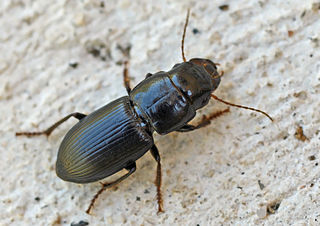
Acinopus is a genus of beetles in the family Carabidae, containing the following species:
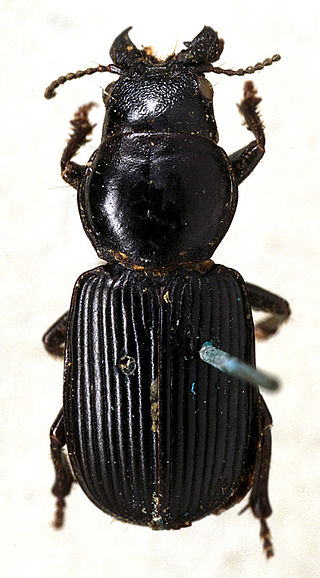
Orthogoniinae is a subfamily of ground beetles. Occasionally it was treated as a tribe Orthogoniini of subfamily Harpalinae, particularly when this was circumscribed loosely.

Pelecium is a genus of beetles in the family Carabidae, containing the following species:
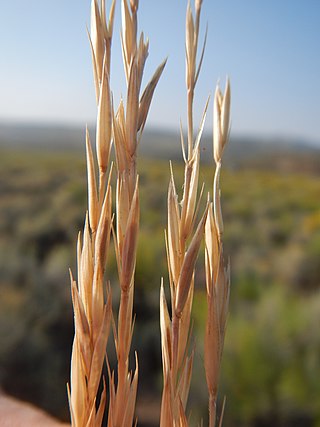
Leymus salina is a species of grass known as Salina wildrye, Salina Pass wild rye, and saline wildrye. It is native to the western United States and is named for its type locality: Salina Pass, Utah.
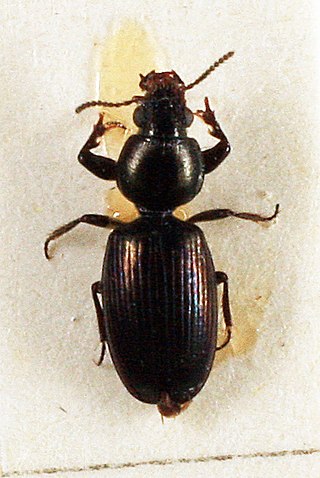
Dyschirius is a genus of beetles in the family Carabidae:
Harpalus salinus is a species of ground beetle native to Europe, where it can be found in Ukraine and southern part of Russia. It is also found in such Asian countries as Afghanistan, Kazakhstan, Kyrgyzstan, Tajikistan, Indian province Kashmir, and Chinese ones such as Xinjiang, Xizang and Tibet.
Dyschirius bacillus is a species of ground beetle in the subfamily Scaritinae. It was described by Hermann Rudolph Schaum in 1857.
Dyschirius importunus is a species of ground beetle in the subfamily Scaritinae. It was described by Schaum in 1857.
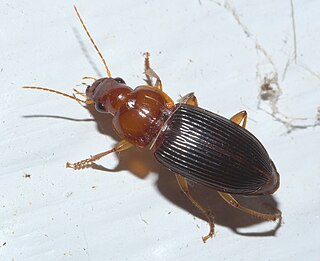
Harpalini is a tribe of a diverse group of ground beetles belonging to the subfamily Harpalinae within the broader family Carabidae. The tribe contains more than 1,900 species.

Rhipiceridae is a family of beetles found worldwide. The larva of rhipicerids are parasitoids of cicada nymphs. Rhipiceridae and Dascillidae form the super family Dascilloidea, within the Elateriformia.














